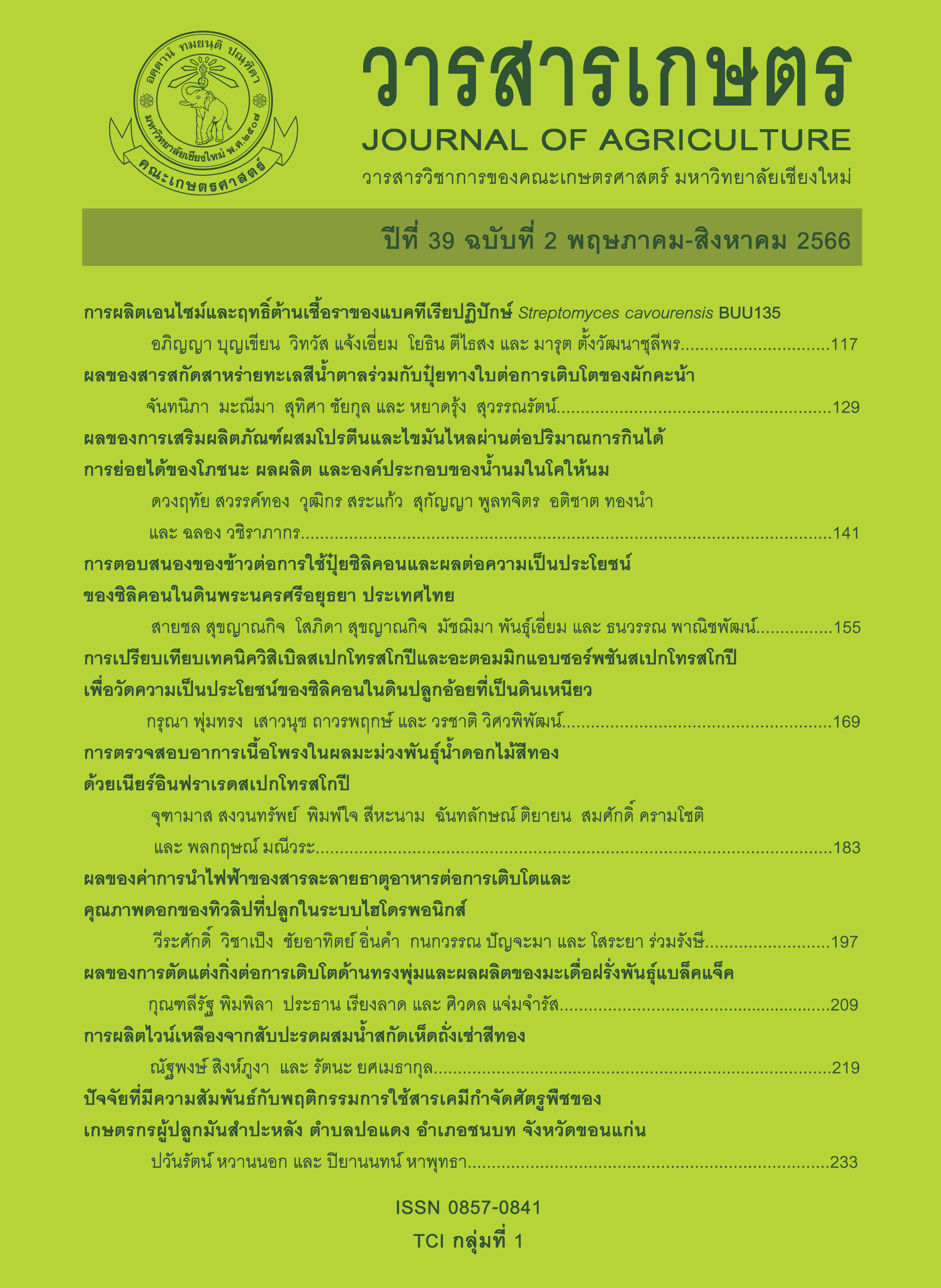ผลของค่าการนำไฟฟ้าของสารละลายธาตุอาหารต่อการเติบโตและคุณภาพดอกของทิวลิปที่ปลูกในระบบไฮโดรพอนิกส์
Main Article Content
บทคัดย่อ
ความเข้มข้นของสารละลายธาตุอาหารซึ่งวัดด้วยค่าความนำไฟฟ้าของสารละลายเป็นปัจจัยหนึ่งที่มีความสำคัญต่อการเจริญเติบโตของทิวลิปที่ปลูกในระบบไฮโดรพอนิกส์ ค่าความเข้มข้นของสารละลายที่เหมาะสมนำไปสู่คุณภาพดอกที่ดี อย่างไรก็ตาม งานวิจัยที่เกี่ยวข้องกับความเข้มข้นของสารละลายธาตุอาหารที่เหมาะสมการเติบโตของทิวลิปในประเทศไทยยังมีรายงานอยู่น้อยมาก การทดลองนี้จึงมุ่งที่จะศึกษาผลของระดับความเข้มข้นของสารละลายธาตุอาหารต่อการเจริญเติบโตของทิวลิปพันธุ์ ‘Orange Juice’ ทำการศึกษาโดยปลูกหัวทิวลิปขนาดเส้นรอบวงเฉลี่ย 12 เซนติเมตร ในระบบไฮโดรพอนิกส์ด้วยการใช้กระถาง 2 ชั้น ในโรงเรือนที่มีการควบคุมอุณหภูมิ เฉลี่ย 20 ± 2 องศาเซลเซียส ความเข้มแสงเฉลี่ย 442 ไมโครโมลต่อตารางเมตรต่อวินาที ความชื้นที่ 80 - 90 เปอร์เซ็นต์ วางแผนการทดลองแบบสุ่มสมบูรณ์ โดยให้พืชได้รับสารละลายธาตุอาหารที่มีค่า EC ต่างกัน 5 ระดับ ได้แก่ 0, 1.0, 1.5, 2.0 และ 2.5 เดซิซีเมนส์ต่อเมตร กรรมวิธีละ 4 ซ้ำ จากนั้นทำการเก็บข้อมูลการเจริญเติบโต การสังเคราะห์แสง คุณภาพดอก และคุณภาพหัวใหม่ ผลการทดลองพบว่า ทุกกรรมวิธีให้ผลของจำนวนวันที่ดอกบานและเส้นผ่านศูนย์กลางก้านดอกไม่แตกต่างกันอย่างมีนัยสำคัญทางสถิติ อย่างไรก็ตาม กรรมวิธีที่พืชได้รับความเข้มข้นของสารละลายธาตุอาหารที่มีค่า EC 0, 1.0, 1.5 เดซิซีเมนส์ต่อเมตร มีอัตราการสังเคราะห์แสงและอัตราการคายน้ำไม่แตกต่างกัน ส่วนในความเข้มข้นที่มีค่า EC 2.0 และ 2.5 เดซิซีเมนส์ต่อเมตร ทำให้ความสูงต้น น้ำหนักสด ความยาวก้านดอก อัตราการสังเคราะห์แสงและอัตราการคายน้ำของทิวลิปลดลง แต่น้ำหนักสดหัวใหม่ เส้นรอบวงหัวใหม่ และจำนวนหัวใหม่ไม่แตกต่างกัน ทิวลิปที่ปลูกในสารละลายธาตุอาหารที่มีค่า EC 0 เดซิซีเมนส์ต่อเมตร พบอาการก้านดอกล้มสูงถึง 66.6 เปอร์เซ็นต์ ในขณะที่กรรมวิธีที่ได้รับสารละลายธาตุอาหารค่า EC 2.5 เดซิซีเมนส์ต่อเมตร พบอาการดอกแท้ง 22.2 เปอร์เซ็นต์
Article Details

อนุญาตภายใต้เงื่อนไข Creative Commons Attribution-NonCommercial-NoDerivatives 4.0 International License.
เอกสารอ้างอิง
Albornoz, F., J.H. Lieth and J.A. González-Fuentes. 2014. Effect of different day and night nutrient solution concentrations on growth, photosynthesis, and leaf NO3- content of aeroponically grown lettuce. Chilean Journal of Agricultural Research 74(2): 240-245.
De Hertogh, A. 1974. Principles for forcing tulips, hyacinths, daffodils, Easter lilies and Dutch irises. Scientia Horticulturae 2(4): 313-355.
Dole, J.M. and H.F. Wilkins. 1999. Floriculture Principles and Species. 2nd ed. Prentice-Hall, New Jersey. 1048 p.
Gorbe, E. and A. Calatayud. 2010. Optimization of nutrition in soilless systems: A Review. Advances in Botanical Research 53: 193-245.
Hoagland, D.R. and D.I. Arnon. 1950. The Water-Culture Method for Growing Plants Without Soil. Circular 347. California Agricultural Experiment Station, The College of Agriculture, University of California, Berkeley. 32 p.
Hsiao, T.C. 1973. Plant responses to water stress. Annual Review of Plant Physiology 24: 519-570.
Ho, L.C. and P. Adams. 1995. Nutrient uptake and distribution in relation to crop quality. Acta Horticulturae 396: 33-44.
Klougart, A. 1980. Calcium uptake of tulips during forcing. Acta Horticulturae 109: 89-95.
Lee, K.H. and J.-K. Suh. 2005. Effects of nutrient solution composition and plant growth retardants on growth and flowering in hydroponics of cut tulip. pp. 519-523. In: International Symposium on Flower Bulbs, Niigata.
Le Nard, M. and A.A. De Hertogh. 1993. Tulipa. pp. 617-682. In: A.A. De Hertogh and M. Le Nard (eds.). The Physiology of Flower Bulbs. Elsevier, Amsterdam.
Li, Y.L. and C. Stanghellini. 2001. Analysis of the effect of EC and potential transpiration on vegetative growth of tomato. Scientia Horticulturae 89(1): 9-21.
Maslanka, M. and A. Bach. 2014. Induction of bulb organogenesis in in vitro cultures of tarda tulip (Tulipa tarda Stapf.) from seed-derived explants. In Vitro Cellular & Developmental Biology – Plant 50(6): 712-721.
Miller, W.B. 2002. A primer on hydroponic cut tulips. Greenhouse Product News 12(8): 8-12.
Khodorova, N.V. and M. Boitel-Conti. 2013. The role of temperature in the growth and flowering of geophytes. Plants 2(4): 699-711.
Nelson, P.V. and C.E. Niedziela Jr. 1998. Effects of calcium source and temperature regime on calcium deficiency during hydroponic forcing of tulip. Scientia Horticulturae 73(2-3): 137-150.
Olympios, C.M. 1999. Overview of soilless culture: Advantages, constraints and perspectives for its use in Mediterranean countries. Cahiers Options Méditerranéennes 31: 307-324.
Puripunyavanicha, V., A. Pagpianb and W. La-ongsri. 2019. First endeavour to produce Tulip bulbs in Thailand. pp. 356-362. In: Proceedings of the Burapha University International Conference 2019. Chonburi. (in Thai)
Rouphael, Y., M. Cardarelli, E. Rea and G. Colla. 2008. The influence of irrigation system and nutrient solution concentration on potted geranium production under various conditions of radiation and temperature. Scientia Horticulturae 118(4): 328-337.
Royal FloraHolland. 2017. The value of cut flowers on Royal FloraHolland (Online). Available: https://np- royalfloraholland-production.
s3-eu-west-1.amazonaws.com/3-Financieel /Documenten/Jaarverslagen/royal-floraholland-annual-report-2017-EN.pdf (December 1, 2021)
Ruamrungsri, S. 2015. Physiology of Flowers Bulbs. Faculty of Agriculture, Chiang Mai University, Chiang Mai. 276 p. (in Thai)
Saloner, A. and N. Bernstein. 2020. Response of medical cannabis (Cannabis sativa L.) to nitrogen supply under long photoperiod. Frontiers in Plant Science 11: 572293, doi: 10.3389/fpls.2020.572293.
Samarakoon, U.C., P.A. Weerasinghe and W.A.P. Weerakkody. 2006. Effect of electrical conductivity (EC) of the nutrient solution on nutrient uptake, growth and yield of leaf lettuce. Tropical Agricultural Research 18: 13-21.
Savvas, D., G. Manos, A. Kotsiras and S. Souvaliotis. 2002. Effects of silicon and nutrient-induced salinity on yield, flower quality and nutrient uptake of gerbera grown in a closed hydroponic system. Journal of Applied Botany 76: 153-158.
Sonneveld, C. and W. Voogt. 2008. Nutrient concentrations of plant tissues of greenhouse crops as affected by the EC of the external nutrient solution. Acta Horticulturae 779: 313-320.
Sruamsiri, P. 2012. Mineral Nutrient in Horticultural Crop Production. Faculty of Agriculture, Chiang Mai University, Chiang Mai. 326 p. (in Thai)
Taiz, L. and E. Zeiger. 2002. Plant Physiology, 3rd ed. Sinauer Associates, Sunderland Massachusetts. 623 p.
Van Ieperen, W. 1996. Effects of different day and night salinity levels on vegetative growth, yield and quality of tomato. Journal of Horticultural Science 71(1): 99-111.


